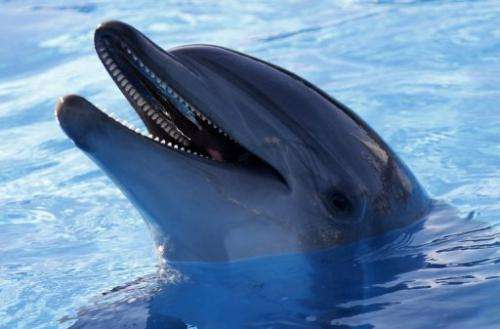Measles-like virus blamed for Atlantic dolphin deaths (Update)

A virus that is similar to measles in humans is suspected of killing hundreds of Atlantic bottlenose dolphins since July, US officials said Tuesday.
Morbillivirus infects the lungs and the brain, causing pneumonia and abnormal behavior, and is often fatal, experts at the National Oceanic and Atmospheric Administration said.
The outbreak has killed 333 bottlenose dolphins in the mid-Atlantic region since July, and may endure for a year, possibly topping the last major outbreak 25 years ago, which killed over 740 animals.
"We are now calling this a morbillivirus outbreak," said Teri Rowles of the NOAA Fisheries Marine Mammal Health and Stranding Response Program.
Thirty-two of 33 dolphins tested have been confirmed positive or are suspected of dying from morbillivirus, which can cause lesions on the skin, mouth, joints and lungs.
Rowles said the death count may end up higher than the 1987-1988 morbillivirus outbreak from New York to Florida, which was the last major event of its kind along the US East Coast.
"We are expecting that if indeed this plays out the way that die-off occurred, that we are looking at mortality being higher and morbillivirus spreading southward and likely continuing until spring of 2014," she told reporters.
Nine times the average number of dolphins have washed up along the shores of the East Coast this summer, in what NOAA has described as an "unusual mortality event," or UME.
Most of the dolphins have been found already dead on the beaches.
Viruses in the same family can cause measles in humans, canine distemper in dogs and wolves and rinderpest in cattle, the NOAA said.
The virus typically spreads among animals in close contact.
While it is unclear what sparked the latest outbreak, scientists think that some sea creatures have natural immunity to morbillivirus, but others do not. When the two populations come in contact, mass illness and death can occur in the weaker animals.
"There is a tipping point in populations," said Stephanie Venn-Watson of the National Marine Mammal Foundation.
"The primary hypothesis is that East Coast dolphins simply don't have the immune response to effectively fight off this virus."
Lance Garrison of the NOAA's Southeast Fisheries Science Center described the 1987-88 die-off of dolphins due to morbillivirus as "very significant."
There are four distinct populations of bottlenose dolphins off the Atlantic coast, including about 22,000 living near the shore and nearly 82,000 in deeper waters.
"One of the real challenges... is determining which actual populations of bottlenose dolphins are affected," added Garrison.
Experts say there is no way to stop the spread of the virus in wild dolphins.
However, the illness is not likely to spread to humans.
"All morbilliviruses known to date infect a small number of closely related species," said Jerry Saliki, a virologist with the University of Georgia.
"So there is no indication that this virus could jump into humans given the species gap between marine mammals and humans."
A total of 488 bottlenose dolphins have been stranded so far this year along the coast from New York to North Carolina, compared to 167 last year, the NOAA said.
© 2013 AFP
















